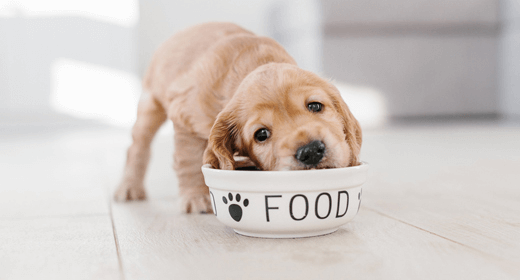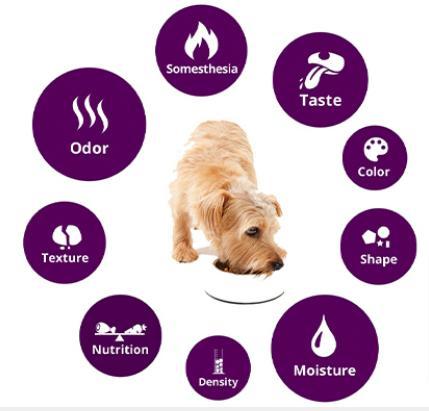

Even if a pet food is formulated to provide all of the essential nutrients required by a dog, it is of little value if the animal will not eat it. Quality pet foods are carefully formulated not only to be highly nutritious but also to be highly palatable.
Highly palatable dog food recipes contain various ingredients and raw materials, including palatants. Palatants help improve the smell, flavor, and texture of your dog’s food. Examples of palatants include fat, salt, proteins, yeasts, and other flavors that are added to make food taste better. Dry foods usually need extra palatants to make them more pleasant and appealing.
Palatability is a term used to describe how well a dog likes the taste, smell, and texture of a food. A premium dog-food manufacturer spends a considerable amount of time conducting controlled feeding studies to determine the right combination of ingredients and processing techniques to produce a nutritious, palatable food.
There are two ways to test and measure the palatability of a dog food:
First Bite: The first palatability test is called the “first bite” preference. This measures the dog's first impression of a food's aroma and appearance.
Total Volume: Because the novelty of a new diet can cause highs and lows in first-bite tests, a second test is conducted called “total volume” measurement. Total volume determines the staying power or ability of a diet to maintain the animal's interest over time. This is the dog’s overall choice of a food based on taste, texture, and nutrition for the entire test period.
Dogs can become picky eaters for a variety of reasons. Some of the reasons why dogs can become picky eaters include:
In comparison to humans, dogs have significantly more smell sensors than taste receptors. This implies that foods with stronger aromas tend to appeal to dogs more. While scent is crucial, less odorous meals like dry kibble can also improve your dog’s food palatability. A dog’s taste buds are hard-wired to sense the presence of fats as well as salt (but not necessarily salt flavor). Fat is frequently added to kibble to improve flavor and palatability without making the food stinky.
While taste and scent are some of the primary ways a dog decides if something is pleasant, palatability can also be influenced by a wide range of factors, such as the dog’s unique preferences and even the owner’s preference for meals and feeding times.
To make a dog eat food, you need to:
Everybody in the household needs to accept and follow the pet’s feeding plan from the beginning. You should be consistent and rigorously adhere to your dog's diet. If you decide to give your dog leftovers, choose to combine nutritious foods with kibble.
Offering your dog table scraps often promotes begging and throws off your pet’s diet. It can also lead to several health issues, including diarrhea and pancreatitis. Although human food is far more palatable, it is less healthy than canned or dry dog food.
Puppies need to be fed two to three times a day, or as your vet may prescribe. As they get older, you can gradually increase the serving size while offering meals just once or twice a week. Additionally, you must add some variety and deliver equal servings. Allowing a schedule also helps keep your dogs weight in check.

In order to obtain and interpret accurate results, palatability studies must be performed by experienced animal technicians and the data analyzed by research nutritionists. Feeding studies are conducted by offering an animal two bowls of food at the same time. Each bowl contains a different diet that has been carefully weighed and recorded.
The technician observes which food the dog chooses to eat first, and then records that as the first-bite preference. After a specific time period, bowls are removed, and any remaining food is weighed and recorded. Diets also are switched from left to right each day of the study to ensure that dogs are not eating one diet simply out of habit.
The total-volume measurement is determined by calculating the difference between the beginning and ending weights of each food. This procedure is repeated using the same two diets with the same group of dogs for five days. At the end of the five-day study, all observations and data are compiled and analyzed to determine the overall palatability of each diet.
Here is a quick look at some flavors that can appeal to your pet.
Meaty Flavor
Animal Fats
Gravy or Stews
Dogs are attracted by not only the taste of a food, but also to its sight, aroma, and texture. Dogs are particularly interested in the smell of food.
If you are wondering how to increase palatability of dog food, here are a few tips that might help.
Select The Right Protein
Whether your pooch prefers dry or wet dog food, remember that the choice of protein is extremely essential. The most palatable dog foods are ones that are available in different meaty flavors such as lamb, beef, and chicken.
Liquid digest is simply protein that is enzymatically broken down into amino acids, which are the building blocks of protein. The enzymatic process reduces large protein pieces to smaller protein pieces and free amino acids. By adding small amounts of acid, the enzymatic or digestive reaction is stopped, and a stable liquid ingredient is produced. After a dry-food formula is cooked, formed into kibbles, and dried, the liquid digest is sprayed evenly on the outside of the dry kibbles. This is called “enrobing.” Not only does the liquid digest make the food highly palatable, but it also adds to the overall digestibility of the food.
Yes. We use liquid digest made from chicken to enhance the palatability of dry foods and to contribute to the nutritional value of the diet. Some pet foods include flavor enhancers, such as onion powder, which simply mask the aroma and taste of the ingredients and provide no nutritional benefits to the animal.
If you're looking for the perfect dog for you, try our Dog Breed Selector today and enjoy a lifetime of tail-wagging joy.
There are several brands that offer highly palatable dog food. These foods contain meat that is rich in protein and good for your dog's growth. Meat also helps in the healing of tissues.
Dogs prefer meats like beef and pork to lamb. They also like warm, wet foods over cold, dry foods. What’s more interesting is that dogs tend to prefer some variety in their food and may get bored if they constantly receive the same dish.
Yes, your picky dog will eventually prefer to eat what it is served overeating nothing at all. All you need to do is have patience. A dog that is a picky eater might turn down a few meals, but once it becomes too hungry, the pooch will eventually eat what is offered.
Some dogs like all types of foods whereas others are more particular and fussier. If your dog prefers and eats other kinds of food, such as wet food, then you have a picky eater.
You can offer a variety of food items to dogs who are picky eaters. These include dry-scrambled eggs, vegetable broth, and frozen or fresh water-based vegetables.


At the heart of your dog's vitality lies vitamin K. From ensuring proper blood clotting to promoting robust bone health, the importance of vitamin K for dogs’ well-being cannot be overstated. In this blog, we will uncover the benefits surrounding this essential nutrient, exploring its sources, functions, and why it is imperative for fostering a healthy and happy life for your furry friend.
Vitamin K, a crucial fat-soluble nutrient for dogs, holds paramount importance in their overall health. Best known for its role in blood clotting, vitamin K ensures your canine companion's body can effectively respond to injuries by forming clots, preventing excessive bleeding. Beyond its hemostatic function, vitamin K plays a key role in bone health, regulating calcium and supporting protein synthesis crucial for maintaining bone density.
Two main forms, K1 (found in green leafy vegetables) and K2 (sourced from animal products and fermented foods), highlight the importance of a diverse diet. Understanding these sources and functions is pivotal, ensuring your dog receives a balanced nutritional intake.
Yes, dogs can and should have vitamin K as part of their diet. While dogs can synthesise some vitamin K on their own, it is often not sufficient for their overall health. However, it's important to note that dog diets should be carefully curated, as excessive vitamin K supplementation can lead to adverse effects. Always consult with your veterinarian to determine the appropriate amount of vitamin K for your dog's specific needs. By incorporating the right sources of vitamin K into your dog's diet, you contribute to their blood clotting, bone health, and overall well-being.
Yes, Vitamin K is beneficial for dogs and plays a crucial role in maintaining their overall health. As mentioned previously, vitamin K is essential for blood clotting, which is vital in preventing excessive bleeding in case of injuries or wounds. It also contributes to bone health and supports the proper functioning of the cardiovascular system. Including sufficient vitamin K in a dog's diet is particularly important to ensure their blood coagulation mechanisms are functioning optimally.
While vitamin K is generally safe for dogs, it is essential to provide it in appropriate amounts. Excessive intake of vitamin K for dogs may lead to adverse effects, so it is recommended to consult with a veterinarian to determine the right dosage for your dog's specific needs. Additionally, pet parents should be cautious about offering human supplements, as they may contain ingredients that are harmful to dogs.
Understanding the diverse benefits of vitamin K for dogs is crucial in crafting a well-rounded approach to their nutritional needs. From supporting blood clotting to contributing to bone health, vitamin K plays a multifaceted role in enhancing your canine companion's overall well-being.
Vitamin K is pivotal in the synthesis of clotting factors, enabling your dog's blood to coagulate effectively. This ensures a rapid response to injuries, preventing excessive bleeding from minor wounds and promoting a quicker recovery process.
Beyond its hemostatic function, vitamin K regulates calcium within bones and facilitates the synthesis of proteins vital for maintaining optimal bone density. This not only supports skeletal strength but also contributes to a reduced risk of bone-related issues in your dog.
Research suggests that vitamin K possesses anti-inflammatory properties, potentially aiding in managing conditions characterized by inflammation, and promoting a more comfortable and active life for your furry friend.
Serving as an antioxidant, vitamin K helps protect cells from damage, fortifying your dog's cellular health and bolstering their immune function against external stressors.
Emerging studies indicate a potential link between vitamin K for dogs and cardiovascular health, with the vitamin playing a role in preventing the calcification of arteries. This aspect highlights the broader impact of Vitamin K on your dog's systemic well-being.
Incorporating vitamin K-rich foods into your dog's diet can harness these benefits, but it's essential to consult with your veterinarian to tailor a nutrition plan that aligns with your dog's specific needs and ensures a vibrant and healthy life.
Navigating the nutritional landscape for your canine companion involves understanding diverse sources of Vitamin K1 and K2. Here is a breakdown of some safe vitamin K foods for dogs:
Vitamin K for dogs is essential for their overall well-being, playing a crucial role in blood clotting and bone health. The importance of a diverse diet, encompassing both K1 and K2 from sources like green leafy vegetables and animal products, cannot be overstated. However, the key lies in moderation, as excessive supplementation may have adverse effects. It is essential to consult with your veterinarian to ensure informed decision-making. By responsibly incorporating vitamin K-rich foods into your dog's meals, you contribute to their resilience to tackle everyday challenges. This nutritional journey fosters a healthy and joyous life for your cherished furry companion.